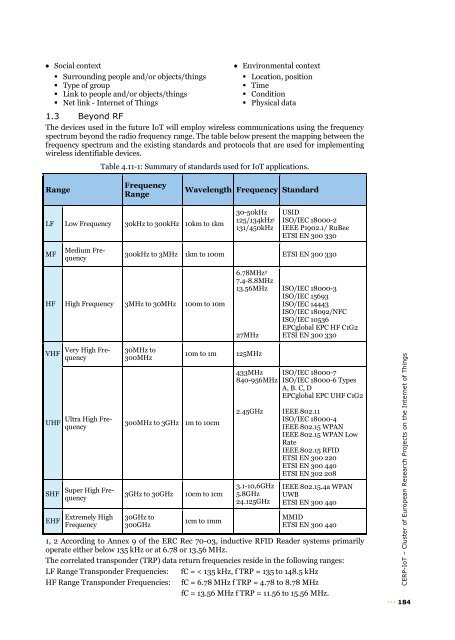Vision and Challenges for Realising the Internet of Things
Vision and Challenges for Realising the Internet of Things
Vision and Challenges for Realising the Internet of Things
Create successful ePaper yourself
Turn your PDF publications into a flip-book with our unique Google optimized e-Paper software.
Social context<br />
Surrounding people <strong>and</strong>/or objects/things<br />
Type <strong>of</strong> group<br />
Link to people <strong>and</strong>/or objects/things<br />
Net link - <strong>Internet</strong> <strong>of</strong> <strong>Things</strong><br />
Environmental context<br />
Location, position<br />
Time<br />
Condition<br />
Physical data<br />
1.3 Beyond RF<br />
The devices used in <strong>the</strong> future IoT will employ wireless communications using <strong>the</strong> frequency<br />
spectrum beyond <strong>the</strong> radio frequency range. The table below present <strong>the</strong> mapping between <strong>the</strong><br />
frequency spectrum <strong>and</strong> <strong>the</strong> existing st<strong>and</strong>ards <strong>and</strong> protocols that are used <strong>for</strong> implementing<br />
wireless identifiable devices.<br />
Table 4.11-1: Summary <strong>of</strong> st<strong>and</strong>ards used <strong>for</strong> IoT applications.<br />
Range<br />
Frequency<br />
Range<br />
LF Low Frequency 30kHz to 300kHz 10km to 1km<br />
MF<br />
Medium Frequency<br />
Wavelength Frequency St<strong>and</strong>ard<br />
30-50kHz<br />
125/134kHz 1<br />
131/450kHz<br />
USID<br />
ISO/IEC 18000-2<br />
IEEE P1902.1/ RuBee<br />
ETSI EN 300 330<br />
300kHz to 3MHz 1km to 100m ETSI EN 300 330<br />
HF High Frequency 3MHz to 30MHz 100m to 10m<br />
VHF<br />
UHF<br />
SHF<br />
EHF<br />
Very High Frequency<br />
Ultra High Frequency<br />
Super High Frequency<br />
Extremely High<br />
Frequency<br />
30MHz to<br />
300MHz<br />
300MHz to 3GHz 1m to 10cm<br />
3GHz to 30GHz 10cm to 1cm<br />
30GHz to<br />
300GHz<br />
6.78MHz 2<br />
7.4-8.8MHz<br />
13.56MHz<br />
27MHz<br />
10m to 1m 125MHz<br />
1cm to 1mm<br />
433MHz<br />
840-956MHz<br />
2.45GHz<br />
3.1-10,6GHz<br />
5.8GHz<br />
24.125GHz<br />
ISO/IEC 18000-3<br />
ISO/IEC 15693<br />
ISO/IEC 14443<br />
ISO/IEC 18092/NFC<br />
ISO/IEC 10536<br />
EPCglobal EPC HF C1G2<br />
ETSI EN 300 330<br />
ISO/IEC 18000-7<br />
ISO/IEC 18000-6 Types<br />
A, B. C, D<br />
EPCglobal EPC UHF C1G2<br />
IEEE 802.11<br />
ISO/IEC 18000-4<br />
IEEE 802.15 WPAN<br />
IEEE 802.15 WPAN Low<br />
Rate<br />
IEEE 802.15 RFID<br />
ETSI EN 300 220<br />
ETSI EN 300 440<br />
ETSI EN 302 208<br />
IEEE 802.15.4a WPAN<br />
UWB<br />
ETSI EN 300 440<br />
MMID<br />
ETSI EN 300 440<br />
1, 2 According to Annex 9 <strong>of</strong> <strong>the</strong> ERC Rec 70-03, inductive RFID Reader systems primarily<br />
operate ei<strong>the</strong>r below 135 kHz or at 6.78 or 13.56 MHz.<br />
The correlated transponder (TRP) data return frequencies reside in <strong>the</strong> following ranges:<br />
LF Range Transponder Frequencies: fC = < 135 kHz, f TRP = 135 to 148.5 kHz<br />
HF Range Transponder Frequencies: fC = 6.78 MHz f TRP = 4.78 to 8.78 MHz<br />
fC = 13.56 MHz f TRP = 11.56 to 15.56 MHz.<br />
CERP-IoT – Cluster <strong>of</strong> European Research Projects on <strong>the</strong> <strong>Internet</strong> <strong>of</strong> <strong>Things</strong><br />
184
















